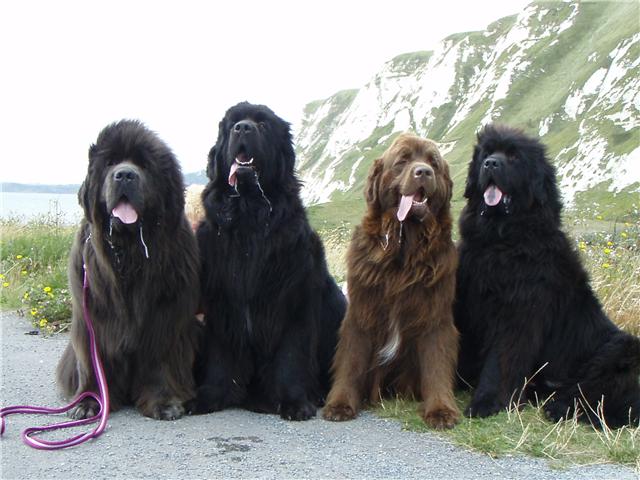Watercubs & Kivisilmän
working show-quality newfoundlands
and history
General information about
colours in Newfoundlands
Colours:
Blacks, browns, black and whites..
The FCI breed standard recognizes three Newfoundland colours: black, black and white, and brown. The standard differs slightly between different countries. The American standard recognizes in addition to the three, the grey colour. In Canada the brown colour is not recognized.
Traditionally majority of Newfoundlands are black. The colour should be as even as possible but slight brown tint on blacks is allowed. The white marks on the chest, toes, and tip of the tail are allowed. The percentage of white disappears as the puppy gets older. Even if a puppy has a large white chest, the colour may not be visible at all when the puppy is fully grown.
Brown Newfoundlands can be chocolate brown or bronze. Many believe that the dark brown colour is more beautiful than the bronze, but it is only a matter of taste. The breed standard does not differentiate between the two. The most important thing in the browns’ colouring is that the colour is even and clean. White marks on the chest, toes and tip of the tail are allowed.
The black and white, often referred to as landseer-colouring is important to the breed’s history. The desired colour distribution: black head with a white stripe extending from the snout to the end of the stop, symmetrical black back, black pelvis and base of tail. The other parts are white and should have minimal black spotting. Breeders and judges often prefer the complete black head, even though the standard asks for the white stripe.
In countries with FCI regulated breed standards, the grey colour on Newfoundlands is not recognized. This colour is often linked to ‘blue dog syndrome’, which refer to severe skin and coat problems. No-one in the FCI countries breed for this colour on purpose, and any born are sold cheaper as pets. Nothing prevents you from having a grey working Newfoundland.
In addition to these colours, there are mutations which do not occur often. The Newfoundland can also be beige, black and tan, or brindle. A dog can also have two of the main colourings, e.g. brown and white or even a white with black and tan colours.
On the Database website (http://newfoundlanddog-database.net/) you can find most of the Newfoundlands’ colourings
.
Colour genetics:
Originally a dog’s base colour was wild-animal grey, which can still be seen on the wolf. The coat colour is not even, and often the tips of the fur are completely black while the middle is white followed by a blacker base colour. The colour of the single hairs are determined by the pigments, whose base colour is either black or dark brown. The fading, lack of ability to produce pigment and chemical changes enable the formation of all the different colours. Part of the genes affect the base colour of the dog, others determine the place where the colour changes. The dogs can have one, two or three different colours with all the possible markings.
The dogs have nine different gene pairs, which all have two or more combination possibilities. No dog can have more than two genes for each pair, but different dogs can have more than just one possible gene in each gene pair.
The genes are marked with letters, and the dominant gene is marked with a capital letter.
A= base colour gene. In addition, the A-set can have the at-gene, which produces dogs with two main colours: black or brown, with yellow on the feet or snout.
B= gene responsible for the production of the black colour. The gene pair’s other gene is b. If the dog does not have B, it is bb, which is brown.
C=gene responsible for producing pigment. If the dog does not have C, it will be an albino.
D= gene responsible for the production of a normal amount of pigment. If the dog does not have this gene, the colour will be lighter than normal. E.g. black becomes grey, brown becomes beige.
E= gene responsible for producing the yellowish brown colour, mask and brindle.
M= comes from the word merle.
R=kimo, which means that darker hairs are distributed in the white parts of the dogs coat if the base colour gene (S) is missing.
S= base colour gene. If the dog does not have S, the coat will have white areas. Other genes in the set are:
sj= white on the feet, stomach and neck.
sp = more white in the coat, which is unevenly distributed.
sw = the coat has a lot of white. The dog is completely white if it does not have the R-gene.
The Newfoundlands’ coat
colour is affected by five gene sets: B-set (black/brown), D-set (dilution),
A-set (agouti, black and tan), S-set (spotting, landseer) and T-set
(ticking).
(c) Salmelin
